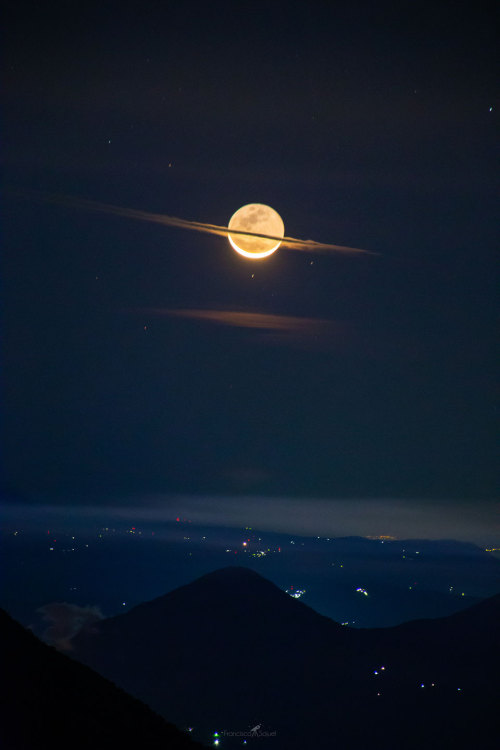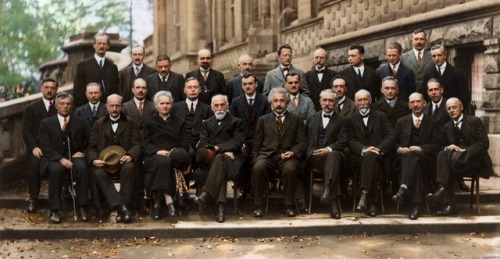A Moon Dressed Like Saturn Via NASA Https://ift.tt/2wb0VHU

A Moon Dressed Like Saturn via NASA https://ift.tt/2wb0VHU
More Posts from Chbnb and Others


Moon minerals

2020 July 16
The Long Tails of Comet NEOWISE Image Credit & Copyright: Petr Horalek
Explanation: This Comet NEOWISE (C/2020 F3) now sweeps through our fair planet’s northern skies. Its long tails stretch across this deep skyview from Suchy Vrch, Czech Republic. Recorded on the night of July 13/14, the composite of untracked foreground and tracked and filtered sky exposures teases out details in the comet’s tail not visible to the unaided eye. Faint structures extend to the top of the frame, over 20 degrees from the comet’s bright coma. Pushed out by the pressure of sunlight itself, the broad curve of the comet’s yellowish dust tail is easy to see by eye. But the fainter, more bluish tail is separate from the reflective comet dust. The fainter tail is an ion tail, formed as ions from the cometary coma are dragged outward by magnetic fields in the solar wind and fluoresce in the sunlight. Outbound NEOWISE is climbing higher in northern evening skies, coming closest to Earth on July 23rd.
∞ Source: apod.nasa.gov/apod/ap200716.html

Mineral Moon by Astrophotographer Andrew McCarthy

Heart of the Scorpion

The Dark River to Antares : A dark river seems to flow through this sky from the horizon toward colorful clouds near red giant star Antares. Murky looking, the dark river is a dusty nebula obscuring background starlight near the central Milky Way, although the dark dust nebula contains mostly hydrogen molecular gas. Dust scattering starlight around Antares, alpha star of Scorpius, creates the unusual yellow-hued reflection nebula. Above it, bright blue double star Rho Ophiuchi is embedded in more typical dusty bluish reflection nebulae, with red emission nebulae also scattered through the interstellar space. Globular star cluster M4 looks almost like a bright star just above and right of Antares, though it lies far behind the colorful clouds, at a distance of some 7,000 light-years. The dark river itself is about 500 light years away. To create the startling night sky view, all background and foreground exposures were made back to back with the same camera and telephoto lens on the same night from the same location. In combination they produce a stunning image that reveals a range of brightness and color that your eye can’t quite perceive. Recorded in the early hours of January 31, the composite also captures Mars still near the eastern horizon and rising to join rival Antares on the celestial stage. Bright Mars and its watery reflection are left of a lonely tree in the Bosque del Apache National Wildlife Refuge, New Mexico, planet Earth. via NASA

Hubble’s Crisp New Image of Jupiter and Europa by Hubble Space Telescope / ESA


Stunning New Images of Jupiter From NASA’s Juno Spacecraft (read article here)

World’s Greatest Physicists, Geniuses Meet in 1927
Solvay Conference 1927
First row: Irving Langmuir, Max Planck, Marie Curie, Hendrik Lorentz, Albert Einstein, Pierre Langevin, Charles Eugene Guye, C. T. R. Wilson, Owen W. Richardson
Second row: Peter Debye, Martin Knudson, W. Lawrence Bragg, Hans Kramer, Paul Dirac, Arthur Compton, Louis de Broglie, Max Born, Niels Bohr
Third row: Auguste Piccard, Émile Henriot, Paul Ehrenfest, Edouard Herzen, Théophile de Donder, Erwin Schrodinger, Jules-Emile Vershaffelt, Wolfgang Pauli, Werner Heisenberg, Ralph Howard Fowler, Leon Brillouin
Absents: Sir W. H. Bragg, H. Delandres et E. Van Aubel
Image credit: Hadi Nur

jake moore photography surf sunset

peak
by Matias Alonso Revelli
-
 innerdaemmon liked this · 1 month ago
innerdaemmon liked this · 1 month ago -
 usofj reblogged this · 1 month ago
usofj reblogged this · 1 month ago -
 sagaduwyrm liked this · 1 month ago
sagaduwyrm liked this · 1 month ago -
 fancyfast liked this · 1 month ago
fancyfast liked this · 1 month ago -
 pinkflowercassy liked this · 1 month ago
pinkflowercassy liked this · 1 month ago -
 class-4-man liked this · 1 month ago
class-4-man liked this · 1 month ago -
 nonchalantxfish reblogged this · 1 month ago
nonchalantxfish reblogged this · 1 month ago -
 imhyou liked this · 2 months ago
imhyou liked this · 2 months ago -
 lor210 liked this · 2 months ago
lor210 liked this · 2 months ago -
 aching-for-strength liked this · 2 months ago
aching-for-strength liked this · 2 months ago -
 blue-brained-loon reblogged this · 4 months ago
blue-brained-loon reblogged this · 4 months ago -
 inhumanrampage reblogged this · 4 months ago
inhumanrampage reblogged this · 4 months ago -
 mackywack reblogged this · 5 months ago
mackywack reblogged this · 5 months ago -
 mackywack liked this · 5 months ago
mackywack liked this · 5 months ago -
 aloy-sobek reblogged this · 5 months ago
aloy-sobek reblogged this · 5 months ago -
 irohzuko liked this · 5 months ago
irohzuko liked this · 5 months ago -
 eggytarty liked this · 5 months ago
eggytarty liked this · 5 months ago -
 gifrascio liked this · 6 months ago
gifrascio liked this · 6 months ago -
 vstorm21 liked this · 6 months ago
vstorm21 liked this · 6 months ago -
 smittycum liked this · 6 months ago
smittycum liked this · 6 months ago -
 envyissin reblogged this · 6 months ago
envyissin reblogged this · 6 months ago -
 envyissin liked this · 6 months ago
envyissin liked this · 6 months ago -
 hexuhgone reblogged this · 6 months ago
hexuhgone reblogged this · 6 months ago -
 chumbi-the-depressive-sheep reblogged this · 6 months ago
chumbi-the-depressive-sheep reblogged this · 6 months ago -
 markus69blog liked this · 6 months ago
markus69blog liked this · 6 months ago -
 companyofgaymen liked this · 6 months ago
companyofgaymen liked this · 6 months ago -
 asilentcapture reblogged this · 6 months ago
asilentcapture reblogged this · 6 months ago -
 cleverdiver liked this · 6 months ago
cleverdiver liked this · 6 months ago -
 two-tickets-to-paradise reblogged this · 6 months ago
two-tickets-to-paradise reblogged this · 6 months ago -
 alexaaaaadsjnfj liked this · 6 months ago
alexaaaaadsjnfj liked this · 6 months ago -
 santosdelrey reblogged this · 6 months ago
santosdelrey reblogged this · 6 months ago -
 golden--babyy reblogged this · 6 months ago
golden--babyy reblogged this · 6 months ago -
 ivan-hx liked this · 6 months ago
ivan-hx liked this · 6 months ago -
 letsboysus liked this · 6 months ago
letsboysus liked this · 6 months ago -
 jalenbmiller reblogged this · 6 months ago
jalenbmiller reblogged this · 6 months ago -
 artisanalprovoker reblogged this · 6 months ago
artisanalprovoker reblogged this · 6 months ago -
 amazingasfrick reblogged this · 6 months ago
amazingasfrick reblogged this · 6 months ago -
 amazingasfrick liked this · 6 months ago
amazingasfrick liked this · 6 months ago -
 mysterywhiteboii liked this · 6 months ago
mysterywhiteboii liked this · 6 months ago -
 echobeach2002 reblogged this · 6 months ago
echobeach2002 reblogged this · 6 months ago -
 cantfindawaytoescape reblogged this · 6 months ago
cantfindawaytoescape reblogged this · 6 months ago -
 cantfindawaytoescape liked this · 6 months ago
cantfindawaytoescape liked this · 6 months ago -
 corriendoconsatanas reblogged this · 6 months ago
corriendoconsatanas reblogged this · 6 months ago -
 echobeach2002 liked this · 6 months ago
echobeach2002 liked this · 6 months ago -
 forever-let-it-burn reblogged this · 6 months ago
forever-let-it-burn reblogged this · 6 months ago
